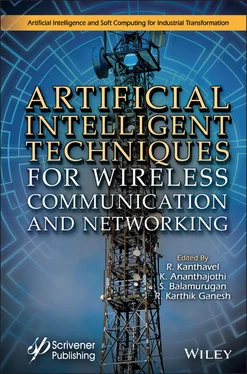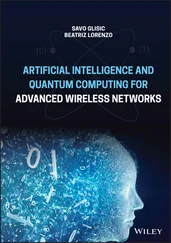Artificial Intelligent Techniques for Wireless Communication and Networking
Здесь есть возможность читать онлайн «Artificial Intelligent Techniques for Wireless Communication and Networking» — ознакомительный отрывок электронной книги совершенно бесплатно, а после прочтения отрывка купить полную версию. В некоторых случаях можно слушать аудио, скачать через торрент в формате fb2 и присутствует краткое содержание. Жанр: unrecognised, на английском языке. Описание произведения, (предисловие) а так же отзывы посетителей доступны на портале библиотеки ЛибКат.
- Название:Artificial Intelligent Techniques for Wireless Communication and Networking
- Автор:
- Жанр:
- Год:неизвестен
- ISBN:нет данных
- Рейтинг книги:5 / 5. Голосов: 1
-
Избранное:Добавить в избранное
- Отзывы:
-
Ваша оценка:
- 100
- 1
- 2
- 3
- 4
- 5
Artificial Intelligent Techniques for Wireless Communication and Networking: краткое содержание, описание и аннотация
Предлагаем к чтению аннотацию, описание, краткое содержание или предисловие (зависит от того, что написал сам автор книги «Artificial Intelligent Techniques for Wireless Communication and Networking»). Если вы не нашли необходимую информацию о книге — напишите в комментариях, мы постараемся отыскать её.
The 20 chapters address AI principles and techniques used in wireless communication and networking and outline their benefit, function, and future role in the field.
Audience
Artificial Intelligent Techniques for Wireless Communication and Networking — читать онлайн ознакомительный отрывок
Ниже представлен текст книги, разбитый по страницам. Система сохранения места последней прочитанной страницы, позволяет с удобством читать онлайн бесплатно книгу «Artificial Intelligent Techniques for Wireless Communication and Networking», без необходимости каждый раз заново искать на чём Вы остановились. Поставьте закладку, и сможете в любой момент перейти на страницу, на которой закончили чтение.
Интервал:
Закладка:
2.4.1.2 AI and Customer Experience
In the next three years, 68% of service providers have stressed the enhancement of customer service as an overall business goal, while 55% have agreed that AI has already a positive impact in this sector. AI is expected to further improve customer experience in many areas, including enhancing network efficiency and delivering customized goods.
2.4.1.3 Recouping the Network Investments That 5G Demands
The key goals that service providers aim to achieve through artificial intelligence are to reduce operating risk and to maintain returns on network investment. Around 70% believe that their network preparation will make the greatest return from digital transformation, while 64% expect to concentrate their IT efforts on network effectiveness management.
2.4.1.4 Data Challenges Presented by Artificial Intelligence Adoption
Network providers accept that efficient processes are required to capture, structure and review massive quantities of data that AI has the ability to collect. A key aspect of the study is the obvious first-mover advantage for early investors at AI, who find today’s and potential obstacles and opportunities. We believe that knowledge can provide the mobile communications industry with exciting opportunities as it can be used to develop a more personal consumer approach while reducing the cost of building and running networks.
2.4.1.5 Network Intelligence and Automation
Network intelligence and automation are crucial to the growth of 5G, IoT and industrial digitalization. With 5G-enabled technology growing, operators will need to increase their network capacity. But with extra power, there is additional complexity.
Consumers are now seeing upwards of 1 Gbps per second over the air as 5G networks are lit up in urban cores and devices begin to enter the market. In addition to better mobile broadband, 5G facilitates the Internet of Things on an unthinkable scale, up to 1 million devices per square kilometer until recently. And as we transition from 3GPP Release 15 to Release 16, changes to enable ultra-reliable low latency communications applications such as precision robotics and remote industrial control in virtually every sector of the economy will drive transformation. In the future, operators are exploring AI today for a variety of use cases that generate value for both the service provider and the consumer. The use of AI in mobile networks is not an aspirational endeavor set for a nebulous period. In reality, 53% of carriers plan to be using AI on their networks by the end of next year, according to recently published research focused on conversations with executives at 132 mobile operators around the world [7].
2.4.2 Challenges to a 5G-Powered AI Network
The 5G rollout is only starting, but the industry hasn’t really discussed what 5G can do with machine learning, understandably. There are some barriers to introducing 5G on a scale so that everybody can use it [2].
2.4.2.1 Dealing With Interference
To start with when they move through physical artifacts, a 5G signal is more vulnerable to interference. To combat this at closer intervals than the 4G network towers we’re used to seeing now, 5G networks will be operated by smaller stations distributed around locations.
2.4.2.2 Dealing With Latency
Another barrier to 5G networks running AI software depends on where the AI software can be run. In terms of computing power and low latency requirements, these systems are very challenging, so they’re not stable without them. A 5G network, too it completely needs low latency, otherwise it’s not beneficial. If the information the AI needs is stored far away from the AI program in a cloud system, and with a 5G network powering it, there would still be too much delay for the work of the AI to be as useful as it should be.
In basic terms, with the distance and congestion of network networks, latency increases. Latency could become a critical issue, depending on the device using the 5G network. Autonomous vehicles, for example, would not operate with high latency systems because they need to identify objects in real time, such as pedestrians. Delays in response times of microseconds may have catastrophic effects for both passengers and others outside the vehicle.
2.4.2.3 Solving Latency
Using edge computing systems inside the network will be a solution to this problem, because it can bring the data and/or computing power required by the AI closer to the AI that does the job. The 5G network will make all this happen more easily, helping the AI to do its job effectively as well.AI software will help make the entire network more predictive, routing traffic as required to the appropriate device or machine, so that whatever data is on it is completely configured to manage it [3].
2.5 Conclusion
5G technology is going to revitalize the cellular infrastructure for internet service providers with mm wavelength frequency support. Wireless AI is still in its early stages and is expected to build smarter wireless networks in the coming years. Network topology, architecture and propagation models, along with user mobility and use patterns in 5G, will be complex. AI can play a critical role in helping telecom operators to deploy, operate and sustain 5G networks with the proliferation of IoT devices. In 5G networks, AI will produce more information and facilitate a move from network management to systems integration. AI can be used to address multiple use cases in order to assist wireless operators move from a human management model to self-driven automated management that transforms network operations and maintenance processes. An in-depth study of the integration with Artificial Intelligence of 5G wireless communication systems is therefore being reviewed.
References
1. https://www.ericsson.com/en/networks/offerings/network-services/ai-report
2. https://www.qualcomm.com/news/onq/2020/02/04/5gai-ingredients-fueling-tomorrows-tech-innovations
3. https://www.thalesgroup.com/en/markets/digital-identity-and-security/mobile/magazine/using-artificial-intelligence-shape-5g
4. Aljumaily, M., AI in 5G and Beyond Networks , Presentation, https://www.researchgate.net/publication/342787463_AI_in_5G_and_Beyond_Networks, 2020.
5. Arjoune, Y. and Faruque, S., Artificial Intelligence for 5G Wireless Systems: Opportunities, Challenges, and Future Research Direction. Semantic Scholar, https://doi.org/10.1109/CCWC47524.2020.9031117,1023–1028, 2020.
6. Bajaj, A., Tamanna, Sangwan, O., SMART 5G: Artificial Intelligence Empowered 5G Networks, Conference: 2nd National Seminar on “Design of 5G Mobile Networks Using Soft Computing Techniques”, Guru Jambheshwar University of Science and Technology, Hisar, Haryana, March 2019.
7. Ge, X., Thompson, J., Li, Y., Liu, X., Zhang, W., Chen, T., Applications of Artificial Intelligence in Wireless Communications. IEEE Commun. Mag. , 57, 12–13, 2019.
8. Goyal, D., Balamurugan, S., Peng, S.-L., Verma, O.P., Design and Analysis of Security Protocol for Communication , John Wiley & Sons, Inc., Bridgewater, NJ, 2020.
9. Haider, N., Baig, M.Z., Imran, M., Artificial Intelligence and Machine Learning in 5G Network Security: Opportunities, advantages, and future research trends, 2020.
10. Javaid, N., Sher, A., Nasir, H., Guizani, N., Intelligence in IoT-Based 5G Networks: Opportunities and Challenges. IEEE Commun. Mag. , 56, 94–100, 2018.
11. Kilinc, C., Sun, C., Marina, M., 5G Development: Automation and the Role of Artificial Intelligence , Wiley online Library, https://onlinelibrary.wiley.com/doi/10.1002/9781119471509.w5GRef128, 2020.
Читать дальшеИнтервал:
Закладка:
Похожие книги на «Artificial Intelligent Techniques for Wireless Communication and Networking»
Представляем Вашему вниманию похожие книги на «Artificial Intelligent Techniques for Wireless Communication and Networking» списком для выбора. Мы отобрали схожую по названию и смыслу литературу в надежде предоставить читателям больше вариантов отыскать новые, интересные, ещё непрочитанные произведения.
Обсуждение, отзывы о книге «Artificial Intelligent Techniques for Wireless Communication and Networking» и просто собственные мнения читателей. Оставьте ваши комментарии, напишите, что Вы думаете о произведении, его смысле или главных героях. Укажите что конкретно понравилось, а что нет, и почему Вы так считаете.












